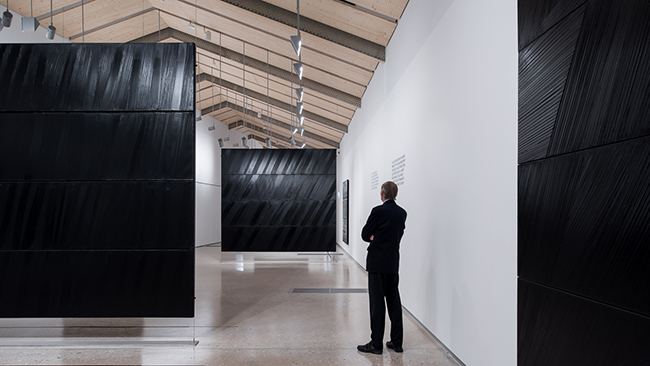From November 5, 2016 to April 23, 2017
By combining EPFL devices and original canvases, the exhibition Noir, c’est noir? Les Outrenoirs de Pierre Soulages has an atypical and experimental character and suggests new ways of understanding, presenting and conserving the works.

Soulages, a prominent figure of abstract painting, explores the properties of the color black. Since 1979, his work has aimed to capture not merely the value of black in itself but the light that it reveals and structures through the range of nuances and aspects of the pictorial matter. By venturing into Outrenoir, which is to say beyond the black, the artist seeks to treat light as a material. Yet his approach, based on his long-term practice of painting and his incessant questioning of its means, in many ways ressembles the scientific understanding of the phenomenon of light.
The curatorial project here does not fall within the confines of a traditional exhibition in a conventional setting, but rather integrates the specificities of a new building on a university campus — creating the conditions for an innovative convergence of art and science. Together with the FGA, five EPFL laboratories alongside startups originating from the school put their research and technologies at the service of an original approach to the Outrenoirs.
The scenographic and scientific features of this exhibition suggest new directions in the understanding, presentation and conservation of these works.
The pilot exhibition Noir, c’est noir? does not limit itself to the tautological allure of its title. It hunts down and overcomes misleading evidence by joining the insights of art with the enlightenment of science.
→ Download the booklet of the exhibition (pdf)
→ Video about the exhibition
Organized jointly by the Fondation Gandur pour l’Art (FGA) and the Ecole polytechnique fédérale de Lausanne (EPFL).
________________________________________________________________________________________
EPFL laboratories experiences in connection with the exhibition
- Into the Black – Virtual reality and mediation
by EPFL+ECAL Lab
- The “Chromatic versatility“ of black
by EPFL+ECAL LAb, start up Gamaya, LTS5 laboratory, Egli Studio and Atelier Héritier
- Bringing an Outrenoir to light
by LTS2 laboratory and Studio Fragment.in
- Ultra-high definition acquisition and interactive visualisation of an Outrenoir
by LCAV laboratory and start up ARTMYN
- Caustics or mastering light
by LGG laboratory and start up Rayform